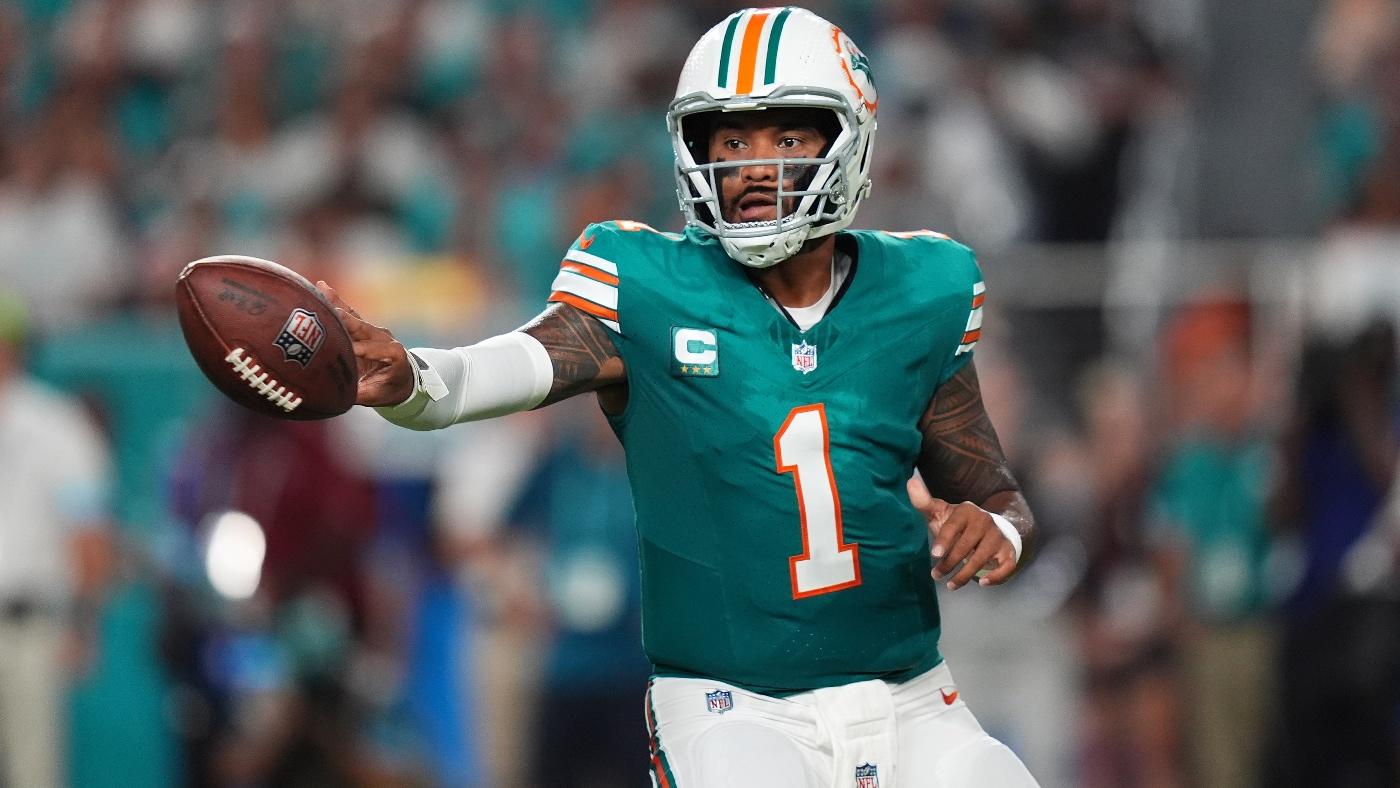
Tua Tagovailoa will make his return-to-match action on Sunday, and he’ll do so in his standard helmet with no parent cap.
Tagovailoa has hurt what the NFL considers the best market for quarterbacks when it comes to reducing the severity of head impact. And by opting for the parent cap on top of that, Tagovailoa is giving up what amounts to redundancy.
Tagovailoa is returning from his third known concussion in his NFL career, and will start against the Cardinals in 45 days and then suffer that concussion in the final 2 against the Charges. He wears a VICIS ZERO2 MATRIX ID QB helmet, which is a quarterback-specific modification of a VICIS helmet that the league has deemed “Guardian Cap optional.”
“For most helmets, adding a Guardian cap, an extra layer of padding, will reduce the force of each hit by 10 to 15%,” famed NFL clinician Allen Sills tells CBS Sports. “There is now a subset of helmets that we label as non-mandatory Parent Cap. And the reason for this was that the helmets in the laboratory tests confirmed that there was actually no longer any other advantage of that magnitude to adding a Parent Cap.
“In other words, the helmet itself was doing as good a job of mitigating force as a regular helmet plus a ward cap. Therefore, adding a ward cap to those helmets did not show the same benefit from 10 to 15 %”.
Technically, the VICIS ZERO2-R MATRIX ID is the non-mandatory helmet for parents, and the only one Tagovailoa uses is the modified quarterback type that provides padding in the occipital region to provide greater protection to a quarterback from more hits. traditional on the back of the pinnacle.
To determine the best-looking helmets, scientists test the devices in laboratories by mimicking on-field collisions involving the types of force, direction and speed visible in professional football. Helmets are ranked based on their effectiveness at reducing power, and compared to information the league can extract from RFID tags on each participant’s helmet to observe power speed on the grass and detect a concussion.
“Because we label each helmet that each player wears, we know exactly the on-field concussion rate for each helmet, and we can go back and compare that to the lab data,” Sills says. “And that’s why we have a lot of confidence in the laboratory data.”
Quarterback Ney, no matter what legal helmet he wears, has damaged a parent cap at the game this season, the first in which these items were approved. The Parent Cap itself weighs about 0.8 kilos.
When asked Monday why he wouldn’t put on the remaining layer of coverage, Tagovailoa said it was a “personal choice.”
After all, Tagovailoa isn’t just any quarterback. He is the only quarterback in the five-season class to have entered the concussion protocol at least three times. He passed the protocol this day and then practiced at first speed because the Dolphins placed him on the injured book. Protocol approval in about six weeks is just a technicality as he wanted to return before getting full clearance, something he was unable to do on IR.
Tagovailoa has stated that he was once symptom-free once he had the concussion. And while he declined to speak particularly about Tagovailoa’s case, Dr. Sills said such reports are not unusual.
“I would just say that we see a substantial number of cases with very transient symptoms after a concussion, meaning that many players are asymptomatic a day or two after an injury,” Sill says. “And I think that demonstrates the fact that we are now very quick to diagnose a concussion with the current system; that means that even if a person has very brief symptoms, we can go ahead and diagnose them with a concussion and put it into practice.” Through that rigorous return to games protocol because we always want to err on the side of caution.
“So I think because we’re so conservative, we’re going to have a number of players that quickly become asymptomatic. And that’s why that’s the group of players that you’ll typically see that don’t miss a game and will come back the next.” week.”
Research has shown that players who suffer repeated concussions are more vulnerable to age-related concussions and that the speed of healing may also be slower. In Tagovailoa’s case, none of the important doctors or experts he has met throughout the generation, while good, will have to give up or may not play again.
When asked today what he would say to fans as he suffers from another head shock, Tagovailoa said: “I appreciate your concern. I really do. I love this game. And I love it to death. That’s all.”
Sills and the NFL were consistent that any return through Tagovailoa would be a call between the patient and clinical executives. The league, Sills has said, no longer practices drugs.
“I have absolute confidence in the Dolphins’ medical staff,” Sills says, “that they are being as thorough and conservative as possible, and that they have deployed all of their local and international resources to give this player the best.” of care and to ensure that all information is available for decision making.

